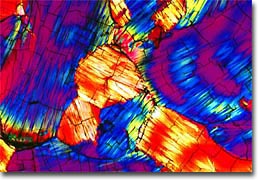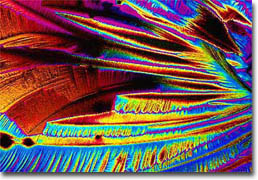AIDS Therapeutics

3'-Azidothymidine (AZT)
Acquired Immuno-Deficiency Syndrome (AIDS) Chemotherapy
|
Learn more about the HIV virus in our Cell Biology review articles. It is now generally accepted in the scientific community that the deadly Acquired Immuno-Deficiency Syndrome (AIDS) is caused in humans by a retrovirus that was dubbed Human Immunodeficiency Virus (HIV) in 1986, several years after it was first isolated independently by Robert Gallo of the United States and French scientist Luc Montagnier. The original source of the virus remains uncertain, although some evidence suggests that it may have been transferred from animals to humans, since a virtually identical virus known as the Simian Immunodeficiency Virus (SIV) has been found in chimpanzees. However, it is also possible that both humans and chimpanzees became infected by a third, unidentified source. The oldest known sample of human fluids containing the virus were obtained in the late 1950s in the region now known as the Democratic Republic of the Congo. 
2',3'-Dideoxycytidine (DDC) Despite its apparently earlier origination, AIDS was not officially recognized as a disease until 1981. Though initially considered a problem solely concerning gay men, it quickly became apparent that AIDS was an issue that involved a much larger body of the population than was first believed. The medical community soon observed that both heterosexual men and women were also victims of AIDS, as were children of both sexes, making many early arguments regarding its occurrence effectively obsolete. Over time a better understanding of the disease developed, and it became commonly understood that HIV, which weakens the immune system by infecting the CD4 cells that are involved in the production of antibodies, can be transferred to individuals through an exchange of body fluids, including blood, semen, vaginal secretions, and breast milk. The term AIDS was itself clarified in light of new information and is today usually considered the final stage of an HIV infection, in which the CD4 cell count of an individual falls below 200 or opportunistic infections and cancers begin to surface. 
Crixivan Many discoveries regarding HIV and AIDS have been made, but an effective cure or vaccination has yet to be developed due to many problems that are involved with such a breakthrough. One of the key difficulties with such an endeavor is the fact that HIV is subject to rapid mutation, enabling the virus to quickly build up resistance to any drugs used to fight it. This characteristic is particularly problematic in regard to possible vaccinations, since mutations also render the virus unrecognizable to the immune system. Moreover, HIV strikes and devastates crucial elements of this system, making it more difficult for a vaccine to successfully stimulate immunity. Even when HIV replication is greatly reduced due to available treatments, the virus is apparently stored in a latent form in a group of cells called resting memory T cells. Thus, when treatment is halted, viral replication again takes place and the immune system of the individual is once again quickly overwhelmed by HIV. Several agents have been found to be efficacious in treatment of the symptoms of AIDS, even though a cure for the disease remains elusive. Interestingly, 3'-azidothymidine (also known as AZT, Retrovir®, and Zidovudine), which was one of the first anti-AIDS medications ever developed, continues to be one of the most effective. During initial clinical trials of the drug using a double-blind placebo, the treated study population displayed a fivefold diminution in mortality rates. It was, therefore, deemed medically unethical to continue withholding the drug from patients receiving the placebo. The trial was soon halted and the United States Food and Drug Administration quickly approved AZT for use by AIDS patients. The mode of the drug's action involves its phosphorylation in vivo to the triphosphate analog, which is mistaken for thymidine triphosphate by the viral-specific DNA replicating enzyme reverse transcriptase. Subsequently, the azido analog is incorporated into the DNA transcript of viral RNA and causes premature chain termination, thus preventing integration of viral double stranded DNA into the host genome. 
2',3'-Dideoxyinosine (DDI) More recently, an array of additional drugs have been approved for use against AIDS. Among the most promising are the di-deoxyribonucleoside derivatives, 2',3'-dideoxycytidine (DDC) and 2',3'-dideoxyinosine (DDI), both of which, similar to AZT, are nucleoside reverse transcriptase (RT) inhibitors. These drugs, when used by themselves or in combination with AZT, often offer suppression of symptoms in patients that are resistant to AZT. Supplementary treatment with non-nucleoside RT inhibitors or a group of drugs known as protease inhibitors can further increase the effectiveness of AZT, DDC, DDI, and similar pharmaceuticals. In fact, in the United States and other industrialized nations, a form of care often referred to as highly active antiretroviral therapy (HAART) that involves the combined use of three or more HIV medications, has resulted in a significant decrease in the mortality rates from HIV in recent years. However, this and other medical means of AIDS treatment can be very expensive and are rarely available to inhabitants of poorer nations, many of which are in the most dire need of relief from the disease. |
© 1995-2025 by Michael W. Davidson and The Florida State University. All Rights Reserved. No images, graphics, software, scripts, or applets may be reproduced or used in any manner without permission from the copyright holders. Use of this website means you agree to all of the Legal Terms and Conditions set forth by the owners.
This website is maintained by our
|